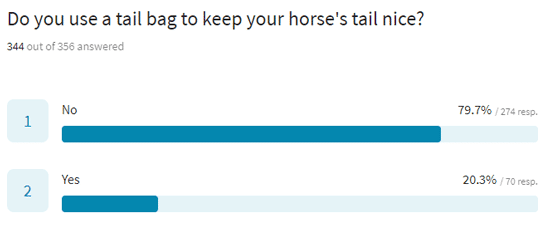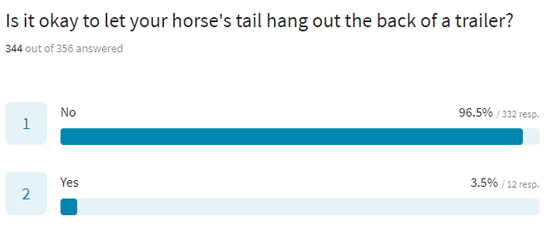Tips and Tricks to Care for Your Horse’s Tail
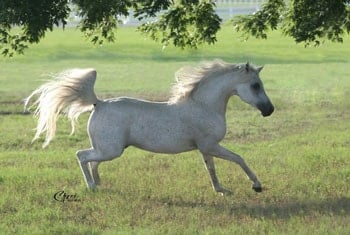 Just imagine, a grand Arabian stallion canters up to you with his flowy tail streaming out like a banner behind him. It flaps and flutters in the breeze. It announces his presence and lets everyone in the area know he is worthy of your admiration.
Just imagine, a grand Arabian stallion canters up to you with his flowy tail streaming out like a banner behind him. It flaps and flutters in the breeze. It announces his presence and lets everyone in the area know he is worthy of your admiration.
That tail… drool...
The tail can be one of the most eye-catching features for your horse. So, why is it that so many tails we see are thin, limp, and ragged? What does it really take to care for your horse’s tail so it grows thick and long?
We decided to do a little digging and learn everything we could about how to care for a horse’s tail. We even asked YOU – our readers – to help with a short survey on tail care. The results provided an interesting glimpse into what you should – and shouldn’t do – to grow those luscious tail locks.
Let’s dive right in.
A Good Tail Starts in the Kitchen
Workout videos will often tell you that six-pack abs are grown in the kitchen. Well, the same goes for a healthy tail on your horse. Without the correct nutrition and supplements, the tail won’t have what it needs to grow long and healthy tail hairs.
Make sure your horse has access to high-quality pasture grass or hay along with the proper amount of grain for his energy requirements. Regular deworming will also keep your horse in good health so they can grow a long and healthy tail.
Supplements are sometimes useful for tail growth. Just like with hooves, tails need B-vitamin biotin, the essential amino acids lysine and methionine, and trace minerals zinc, copper, and iodine. Any hoof supplements that include these minerals and nutrients will also benefit your horse’s tail.
Grooming and Washing Your Horse's Tail
Once you know your horse has the nutrition he needs to grow a healthy tail, we look to more external factors. Yup, let’s talk about washing and grooming that tail!
We recently conducted a survey and 356 of our readers responded. When asked how often they wash and brush their horse’s tail, 56% of you said you do this just at bath time. Then, about 39% said you do this every time you groom.
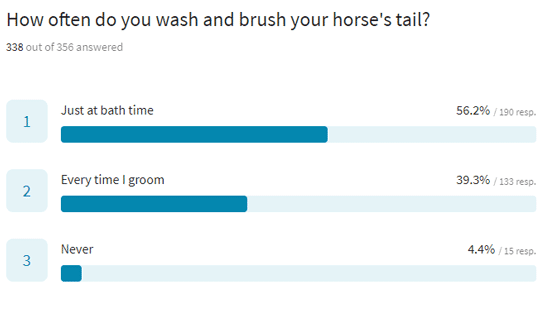
So, what do the experts recommend?
Well, there is a lot of debate on this topic. The 2007 AQHA Horsewoman of the Year, Lynn Salvatori Palm says that, “Grooming a tail every day is important because it stimulates the roots of the hair, which causes the tail to grow.”
She prefers to use a human hair brush or a wide tooth comb to gently untangle tail knots. Others would shudder at the thought of using a brush and just use their fingers to gently go through the tail.
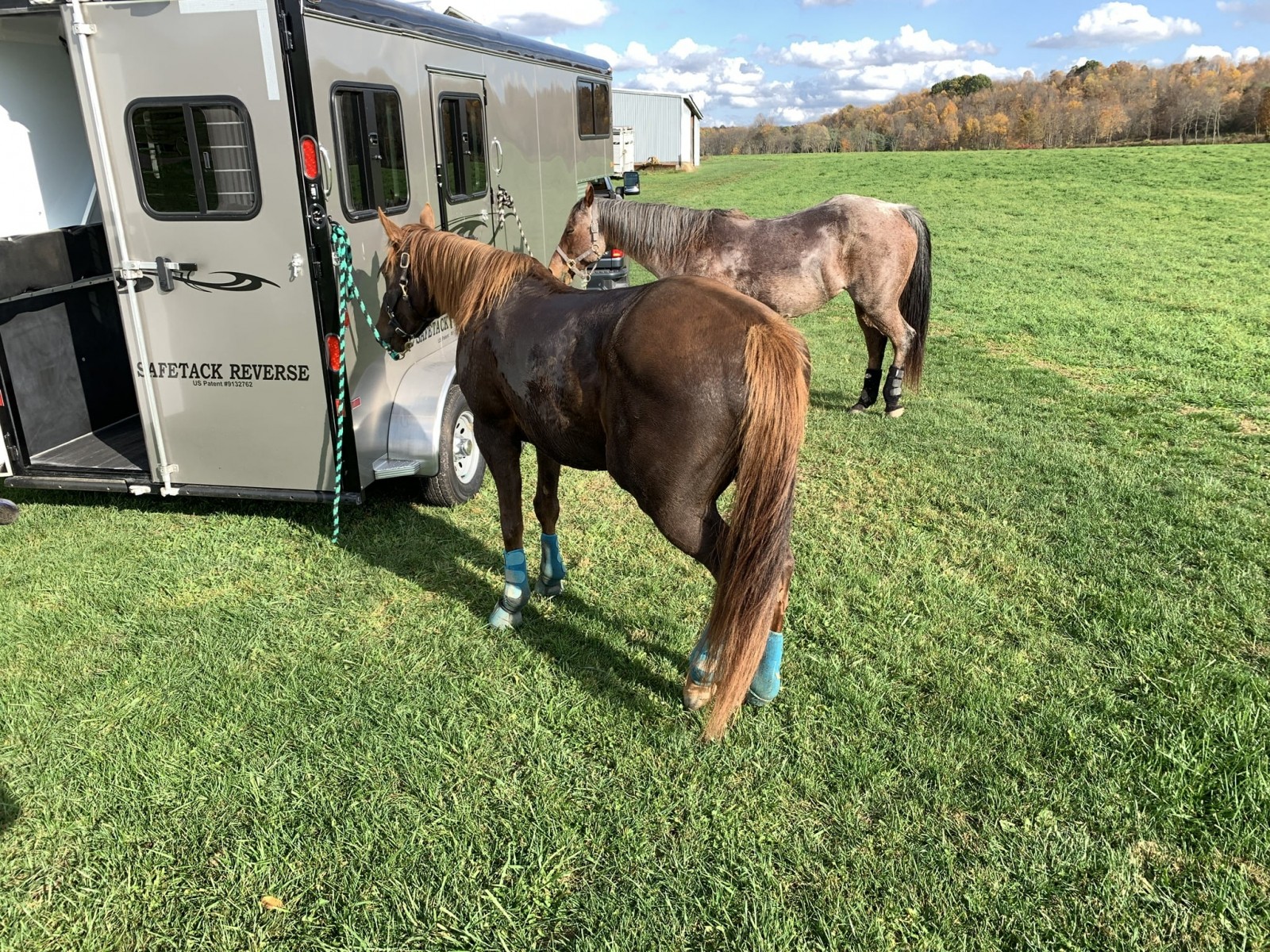
Any hairs that are pulled out mean that your horse’s tail will become a bit thinner. It takes a long time for these hairs to regrow. So, it makes sense to us that most of you leave tail brushing just for bath time.
In terms of washing, use a shampoo designed for horses or humans (not a dishwashing or laundry detergent.) Fully rinse out those suds so they don’t leave behind a residue that may cause itchiness.
One handy technique is to make a little bubble bath for your horse’s tail. Fill a bucket with water and soap. Then, lift it up and dunk your horse’s tail into the bucket. Swish around the hair until it’s nice and clean.
You want to find a nice balance where you’re keeping the tail clean, but not over washing to the point where the skin starts to feel dry and itchy.
It may also be important to check the label of your hair products. Shampoos and conditions that contain sulfates will strip the hair of natural oils. Instead, look for something with natural ingredients like tea tree or coconut oils. (Fancy, right?)
Maintaining a Tail with Wraps or Bags
Once that tail is clean and detangled, we next started to wonder about tail bags and wraps. Our tribe of readers helped once again. A strong majority of 78% did not opt to use tail bags to keep their horse’s tail nice.
Even if you don’t use a tail bag regularly, there are certain times where it may make sense. For instance, if you just cleaned your horse for a show and want the tail to stay nice overnight, you might pop a tail bag on to keep the shavings from wreaking havoc.
When doing this, start a braid below the tail bone in either one or two long strands. Secure the braids with human hair bands and then place into the tail bag. Don’t fasten the bag to the tail bone itself as this can lead to circulation problems.
If you’re doing a show braid on your horse’s tail, you might also consider wrapping the tail so it doesn’t rub out on the trailer. Wraps are available in neoprene or Velcro versions. An ace bandage may also work well. Again, just make sure it’s not wrapped too tightly or circulation will be cut off in the tail dock.
Proper Tail Safety for the Trailer
The next question we posed to our readers was a no-brainer for most people. A whopping 96% agreed that it’s not a good idea for your horse’s tail to hang out the back of an open horse trailer.
Really, this is just for safety reasons. It’s just like those announcements you hear at the theme park… “Please keep all hands and feet (and tails) inside the car at all times!”
At Double D Trailers, we build our straight load trailers with about 6-inches of space between the butt bar and the rear door. This gives the horse a little bit of room to hang his tail if he decides he wants to swish it around without it actually hanging outside the trailer. And, of course, your horse won’t be able to hang is tail outside if you keep the back doors of your trailer fully closed.
Strange Tails May Signal These Health Concerns
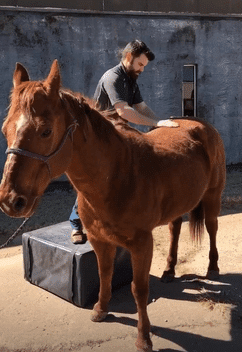
The first one is pretty common – itchiness!!
If your horse has an itchy spot on his underbelly, sheath, or udders, they will try to scratch it by rubbing their butts along a hard surface. Tail rubbing can also be caused by pinworms or an allergy to fly saliva known as “sweet itch.” Over time, tail rubbing can do serious damage – even causing bald spots on the tail bone!
Keep all of these areas clean and deal with any allergy or parasite problems to keep your horse from doing the butt rubbing dance. Proper fly spray application can also help keep the itchiness down.
If you notice your horse holding his tail crooked or off to the side, this may indicate problems with the sacrum (part of the spinal column). Have your vet or a horse chiropractor take a look.
When moving around, some horses have a very active tail. They like to swish it around constantly. If your horse is doing this when they normally have a quiet tail, it may be a sign that they are suffering from back pain or a stomach ulcer.
Use your horse’s tail as a barometer for their overall health by watching for these symptoms.
If you have any questions about tail care or horse trailer safety, feel free to contact Brad Heath at Double D Trailers. You may also be interested in joining the Horse Trailer Forum on Facebook to get all your trailer questions answered directly.
Sources:
Horse & Rider: 9 Tips for a Long, Lovely Tail
Cowboy Magic: 20 Tips for Healthy Tails
US Equestrian: Pro Tip – Mane and Tail Care
Dressage Today: What Your Horse’s Tail Says About His Health

